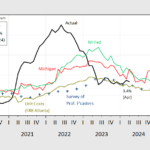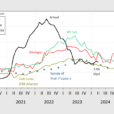

 But while I’ve been pointing to overall weakness in our data since February, today’s data-driven environment is actually quite rare. Our BMI has been trending lower since December 29. That’s a long period…one that suggests a major ultra-bullish signal is approaching.Last week we took a deep dive into our data and found something interesting. When the BMI falls 40+ points in 16 weeks, it’s extraordinary. In fact, over the past 30 years, it has occurred 303 times.While that may not seem exceptional on the surface, in reality, most of those instances cluster around 17 discrete episodes throughout the three-decade period including back-tested data. But history proves these prolonged money flow dips are quite bullish over the medium- to long-term.When we single out similar BMI pullbacks to now, we find six instances ranging from 1998, 2019, and 2020. What we find is stocks struggle near term, with the S&P 500 falling 4.1% a month later and 1.2% three months later. But the underlying message that you need to heed is stocks zoom six and 12 months later, with average gains of 14% and 20.3% respectively.Here’s the bottom line: Investors are looking for clarity in this turbulent market. Data has more answers than the news ever will. We are currently witnessing a rare 40+ point drop in the Big Money Index (BMI). History says a little more pain will lead to monster gains in the coming months.More By This Author:Alamos Gold: With Mining Stocks On The Move, This Growing Gold Producer Should ShineJohnson & Johnson: A Healthcare Giant That’s Looking More Attractive By The DayMarkets Scorecard: Four Months Into The Year, Here’s Where Things Stand
But while I’ve been pointing to overall weakness in our data since February, today’s data-driven environment is actually quite rare. Our BMI has been trending lower since December 29. That’s a long period…one that suggests a major ultra-bullish signal is approaching.Last week we took a deep dive into our data and found something interesting. When the BMI falls 40+ points in 16 weeks, it’s extraordinary. In fact, over the past 30 years, it has occurred 303 times.While that may not seem exceptional on the surface, in reality, most of those instances cluster around 17 discrete episodes throughout the three-decade period including back-tested data. But history proves these prolonged money flow dips are quite bullish over the medium- to long-term.When we single out similar BMI pullbacks to now, we find six instances ranging from 1998, 2019, and 2020. What we find is stocks struggle near term, with the S&P 500 falling 4.1% a month later and 1.2% three months later. But the underlying message that you need to heed is stocks zoom six and 12 months later, with average gains of 14% and 20.3% respectively.Here’s the bottom line: Investors are looking for clarity in this turbulent market. Data has more answers than the news ever will. We are currently witnessing a rare 40+ point drop in the Big Money Index (BMI). History says a little more pain will lead to monster gains in the coming months.More By This Author:Alamos Gold: With Mining Stocks On The Move, This Growing Gold Producer Should ShineJohnson & Johnson: A Healthcare Giant That’s Looking More Attractive By The DayMarkets Scorecard: Four Months Into The Year, Here’s Where Things Stand
















